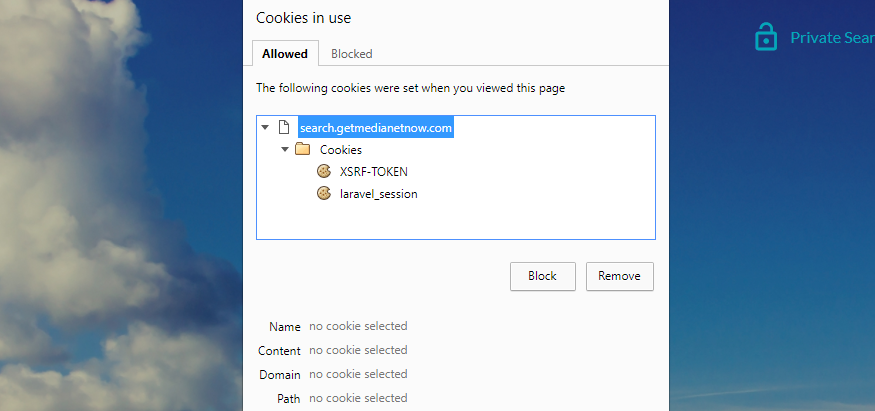
An infection with the dangerous GetMediaNetNow redirect Redirect leads to serious security issues. Victims can restore and protect their computers by following our complete removal guide.
Remove GetMediaNetNow redirect Redirect and Restore PC
Manual Removal Guide
Skip all steps and download anti-malware tool that will safely scan and clean your PC.
SpyHunter anti-malware tool will diagnose all current threats on the computer. By purchasing the full version, you will be able to remove all malware threats instantly. Additional information about SpyHunter / Help to uninstall SpyHunter
Distribution of GetMediaNetNow redirect Redirect
GetMediaNetNow redirect is a new malware which has been reported in various attacks worldwide. At the moment the security experts have not been able to identify a single tactic that is being used to infect the targets. We presume that the hackers are using several of the most important methods to carry out the malicious campaigns.
A common way of setting browser hijacker attacks is the use of email spam messages. They may directly distribute malicious file attachments containing scripts that lead to an infection. Other cases can utilize complex social engineering tricks and hyperlinks that are specifically made to confuse the intended targets into infecting themselves. Two more scenarios that are used in combination with email messages rely on infected files used as payloads ‒ documents and software installers.
- Infected Software Installers ‒ The criminals craft malicious packages made out of legitimate software installers. They are taken from the official vendor download sites, modified and then posted on online sites or attached (either as file attachments) or linked in the email messages.
- Infected Documents ‒ They represent dangerous files that usually come in the form of some of the most popular document types: rich text documents, spreadsheets and databases. When the users open them up a notification prompt will ask them to enable the built-in scripts (macros). If this is done then the malware is installed on the victim computer.
The malware browser plugins can be uploaded to hacker-controlled sites and P2P networks like BitTorrent as well. The hacker operators frequently utilize template design, text and images to create portals that look like legitimate download sources. They may also use domain names that are very similar to legitimate sites and advertise them via pop-ups or ad networks.
The browser hijacker code associated with the GetMediaNetNow redirect Redirect can be found in numerous malware toolbars. They are usually made for the most popular web browsers: Mozilla Firefox, Google Chrome, Internet Explorer, Safari, Microsoft Edge. They can be distributed on such download sites or even on the browsers repositories (such as the Chrome Web Store for Google Chrome) using fake developer accounts.
Impact of GetMediaNetNow redirect Redirect
The GetMediaNetNow Search is a dangerous web redirect that is being made by the eAnswers company. It is part of a large network of similar threats that all seek to impact the victim’s security and privacy.
It follows the traditional browser infection patterns by modifying the most important settings on the victim software. Usually the criminals target the most popular ones (Mozilla Firefox, Google Chrome, Internet Explorer, Opera, Microsoft Edge and Safari). Basic threats usually alter only the three basic parameters related to the browser behavior at first launch: new tabs page, default search engine and home page. As soon as this is done the victims will be redirected to the Search GetMediaNetNow home page. Its layout is similar to other redirects made by the group such as the following:
- VideoNet Search
- MoviesFriendly Search
- FilmsApp Home
Like other similar redirects it the GetMediaNetNow hijacker institutes tracking cookies that monitor and track all user behavior which is reported back to the site operators. This privacy-invasive tactic is used to make profiles of the users, including their preferences and interests which is gathered in a database shared with all other browser hijackers operated by the company. As the GetMediaNetNow redirect infects the web browsers it can also extract sensitive information such as the following: history, bookmarks, preferences, cookies, account credentials and passwords.

The home page is organized into several structures:
- Top Menu Bar — Contains the “Private Search” option and the “Background” preferences button.
- Main Search Engine With Options — Beneath the large logo image the search engine is found. It is a customized engine that includes all the basic search type options (Web, Images, Video and News).
- Service Pages — The bottom menu bar lists the Privacy policy and terms of use documents.
The privacy policy and terms of use documents reveal some of the dangerous security and privacy consequences of using the dangerous GetMediaNetNow redirect. One of the most dangerous aspects is the automatic data collection. The cookies record preferences, browsing patterns and other metrics that are unique to each user. As such they can be analyzed to reveal much information about the users identity and preferences. Advanced versions of browser redirects and hijackers have the ability to infect the computers on a deep level. The use of a complex multi-stage redirect can lead to malware delivery with viruses, malware, ransomware and etc. This is the reason why these threats must be removed immeediately upon infection.
GetMediaNetNow redirect Redirect is a very dangerous threat that must be eliminated completely to prevent any privacy and security risks for the victim users. This is why we we recommend that all users remove the active infections by following our in-depth removal guide.
Remove GetMediaNetNow redirect Redirect and Restore PC
WARNING! Manual removal of the GetMediaNetNow redirect Redirect requires being familiar with system files and registries. Removing important data accidentally can lead to permanent system damage. If you don’t feel comfortable with manual instructions, download a powerful anti-malware tool that will scan your system for malware and clean it safely for you.
SpyHunter anti-malware tool will diagnose all current threats on the computer. By purchasing the full version, you will be able to remove all malware threats instantly. Additional information about SpyHunter / Help to uninstall SpyHunter
GetMediaNetNow redirect Redirect – Manual Removal Steps
Start the PC in Safe Mode with Network
This will isolate all files and objects created by the ransomware so they will be removed efficiently. The steps bellow are applicable to all Windows versions.
1. Hit the WIN Key + R
2. A Run window will appear. In it, write msconfig and then press Enter
3. A Configuration box shall appear. In it Choose the tab named Boot
4. Mark Safe Boot option and then go to Network under it to tick it too
5. Apply -> OK
Remove GetMediaNetNow from Windows
Here’s a way to remove the program. This method will work regardless if you’re on Windows 10, 8, 7, Vista or XP. Simply selecting the program and pressing delete won’t work, as it’ll leave a lot of small files. That’s bad because these leftovers can linger on and cause all sorts of problems. The best way to delete a program is to uninstall it. Here’s how you can do that:
1. Hold the “Windows” button (It’s between CTRL and Alt on most keyboards) and press “R”. You’ll see a pop-up window.

2. In the textbox, type “appwiz.cpl”, then press“ Enter ”.

3. The “Programs and features” menu should now appear. It’s a list of all the programs installed on the PC. Here you can find the program, select it, and press “Uninstall“.

Remove GetMediaNetNow Virus From Your Browser
Before resetting your browser’s settings, you should know that this action will wipe out all your recorded usernames, passwords, and other types of data. Make sure to save them in some way.
-
1. Start Mozilla Firefox. In the upper right corner, click on the Open menu icon and select “Add-ons“.

2. Inside the Add-ons Manager select “Extensions“. Search the list of extensions for suspicious entries. If you find any, select them and click “Remove“.

3. Click again on the Open menu icon, then click “Options“.

4. In the Options window, under “General” tab, click “Restore to Default“.

5. Select “Search” in the left menu, mark the unknown search engine and press “Remove”.

-
1. Start Google Chrome. On the upper-right corner, there a “Customize and Control” menu icon. Click on it, then click on “Settings“.

2. Click “Extensions” in the left menu. Then click on the trash bin icon to remove the suspicious extension.

3. Again in the left menu, under Chrome, Click on “Settings“. Go under “On Startup” and set a new page.

4. Afterward, scroll down to “Search“, click on “Manage search engines“.

5. In the default search settings list, find the unknown search engine and click on “X“. Then select your search engine of choice and click “Make default“. When you are ready click “Done” button in the right bottom corner.

2. In the “Manage add-ons” window, bellow “Add-on Types“, select “Toolbars and Extensions“. If you see a suspicious toolbar, select it and click “Remove“.

3. Then again in the “Manage Add-ons” window, in “Add-on Types“, Select “Search Providers“. Chose a search engine and click “Set as default“. Select the unknown search engine and click “Remove and Close”.

4. Open the Tools menu, select “Internet Options”.

5. In the “General” tab, in “Home page”, enter your preferred page. Click “Apply” and “OK”.

Repair Windows Registry
1. Again type simultaneously the WIN Key + R key combination
2. In the box, write regedit and hit Enter
3. Type the CTRL+ F and then write the malicious name in the search type field to locate the malicious executable
4. In case you have discovered registry keys and values related to the name, you should delete them, but be careful not to delete legitimate keys
Click for more information about Windows Registry and further repair help



